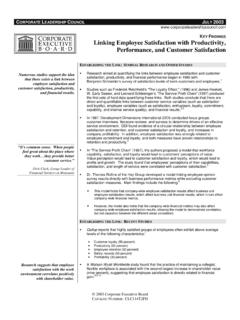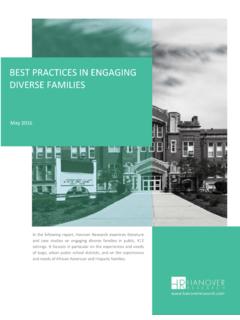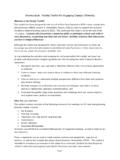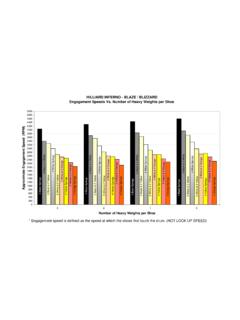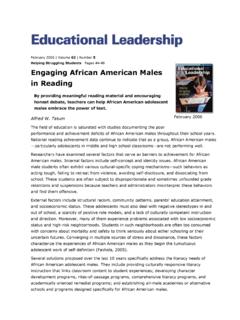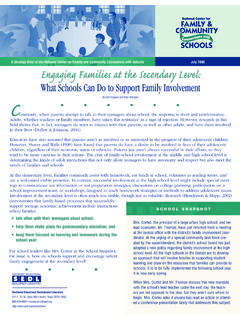Transcription of Engaging the Generations - Beverly Kaye
1 CHAPTER4 Engaging the GenerationsBeverly Kaye, Devon Scheef,ANDD iane ThielfoldtNOLONGER JUSTa problem for families, the generation gap has donned ca-sual business attire and come to work. For the first time in modern history,four Generations are working side by side in most companies. And, just like amultigenerational family, each age group has different motivators, communica-tion styles, and work if this sounds familiar .. Bill, a 61-year-old company veteran, watches the new crop of interns set-tle in at his division. He marvels at their selfish outlook and apparent lackof loyalty.
2 Susan, a 48-year-old mother of two and caretaker for her aging father,looks at her in-basket and wonders how she ll ever find the time to meetthe needs of both her family and her work team. Jennifer, a 30-year-old supervisor, chafes under the attention of her boss. If he doesn t stop micromanaging me and let me do the job my way, I mout of here, she thinks. Greg, a 22-year-old, fresh out of college, is ready to conquer the world. I m going to be a director by the time I m 30, he tells his older cowork-ers, immediately alienating s going on in companies today?
3 Why can t the Generations get along?What used to be humorous grousing around the water cooler has turned into aserious corporate issue as demographics and company needs collide. It s likelyyour organization if not your work team has members of the Silent Genera-tion (born 1933 1945), Baby Boomers (born 1946 1964), generation Xers(born 1965 1976), and maybe even some Millennials (born 1977 1998). And PEOPLE: HR S BOTTOM-LINE ASSET that s only half the story. The prominent feature about the workforce in thefirst half of the 21st century is that it will grow much more slowly than in anyother decade since the 1960s.
4 In fact, researchers predict that we face a work-force shortage ofsomewhere between 15 and 25 million workers in the first 20years of this the Generations : It MakesGood Business SenseHow can you engage each of these Generations , inspire them to stay and suc-ceed? Why is it important that you target each one? If your organization is ex-panding, your diverse workplace should mirror your diverse marketplace; if youneed to attract and retain top talent, your company must appeal to high-qualitycandidates of all ages; if your company suffers from conf licting attitudes aboutwork, misunderstandings over communication, and miscues about motivation,you need to narrow your generation gap.
5 And if you see employees that have quit but are still at their desk every day, you need to not just retain them butalso to truly engage them in their are the top five reasons that organizations need to proactively work onengaging all four your precious knowledge capital walking out the door?Are you seeing an onslaught of Silents and Baby Boomers checking outtheir retirement options? If your workplace is built around Boomers, theaverage age of your employees is somewhere between the late 30s andmid-50s, which means that capturing their expertise is a high and you noticed that your Silent generation andBoomers are inclined to whine when they re dissatisfied and that Gen-eration Xers and Millennials are inclined to walk?
6 Retaining talentedyounger workers is a top challenge for many and can quit and still come to work. Some ofyour key talent may be physically present at work, but not psychologicallythere. It s worse to have them stay and do damage than to go and seekwork fulfillment and you in a race to attract and retain toptalent? Recruiting and retaining high-quality knowledge workers remainsa core challenge as organizations compete for a smaller pool of and u ve noticed that the people you workwith have differences in work ethic, teamwork, expectations of you, andexpectations of the organization, and you wonder if the differences arerelated to their e ng a ge t h e ge nerations, you must first understand them.
7 Let s take a lookat each generation s THE Generations Get to Know the GenerationsThe Silent generation : Your Sagely SilentsMeet Bill and his cohort oldest generation typically found intoday s workplace was born between 1933 and 1945. These oldest membersgrew up in a time of economic turmoil in the aftermath of the Great Depres-sion. They dealt with economic hardships by being disciplined and self-sacrificing. They lived and helped reinforce the American Dream. They haveenjoyed a lifetime of steadily rising aff are 52 million Silents, and they defy generalization more than anyother generation .
8 So watch those stereotypes!Employees from the Silent generation are typically disciplined, loyal teamplayers who work within the system. They have a huge knowledge legacy toshare, and they embody a traditional work s a natural affinity between this generation and the young s a perfect match to have them mentor the youngest generation of employees,and the Silent generation s natural civic-mindedness lends itself to this are various opinions on the birth years that define each generation ,most differing by only a year or two. There are two reasons for this: First, Generations and their characteristics are most clearly defined in retrospect,and there are many opinions as to when a generation began to exhibit itsdefining characteristics.
9 Second, some researchers and sociologists definesubsets of Generations . For example, they view the Baby Boomers as twoseparate groups. Sometimes people born three years on either side of a di-viding year find themselves identif ying with the previous or following gen-eration. Please keep in mind that it s less important to focus on specificdates than it is to concentrate on what managers can do regarding genera-tional to Rocking the Agesby generational ex perts J. Walker Smithand Ann Clurman (Harper-Collins, 1997), members of a generation arelinked through the shared life experiences of their formative years, suchas the economy, world events and politics, and heroes and villains.
10 Thesecommon experiences tie a generation s members together, creating whatsociologists call cohor oftheir shared experiences, cohorts de-velop similar values and life approaches, which are revealed by every-thing from their attitude toward saving money to how they raise theirchildren not to mention how they view work and the workplace. PEOPLE: HR S BOTTOM-LINE ASSETDon t dismiss their technical skills as out of date: Del Webb, a major devel-oper ofhomes for retiring couples, points out that the top requested feature innew homes for retirees is his-and-hers offices.
